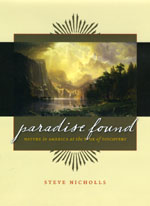“A time machine tour of our continent’s abundant past”

For some time now the movement to preserve natural habitats has gained in popularity as we begin to understand our species’ limited capacity to thrive in isolation from the untold number of other organisms that make up the ecosystems in which we live. And with the clear and present danger posed by mass-extinctions, climate change, and the rapid depletion of natural resources, many long for a return to the abundance that the wilds of North America once offered. But while it is impossible to turn back the hands of time, with Steve Nicholls’ recent book, Paradise Found: Nature in America at the Time of Discovery we can at least gain a clearer picture of what it was like, and perhaps the inspiration to repair the damage. As Marion Elizabeth Rodgers writes a recent review of the book for the Washington Times:
Paradise Found is one of the best books I have read in years. The book guides us easily through the North Atlantic, the East Coast, subtropical Caribbean, the West Coast, Baja California and the Great Plains, seamlessly blending firsthand accounts from historical journals, personal anecdotes and the latest scientific inquiry. Wildlife filmmaker and entomologist Steve Nicholls paints a picture of 500 years of people and nature, giving us a time machine tour of our continent’s abundant past.
And what an abundance there was! Meadows full of ducks, forests filled with all kinds of berries and nuts—oaks, pecans and most plentiful of all, the American chestnut. Those forests were not the same as we know today. These were natural cathedrals, with green roofs arching 50 feet above one’s head; giant trunks measured more than 20 feet in circumference. So many strawberries littered the ground that one naturalist noted his horse’s hooves were being stained red with their juice. At the mouth of a river was an island filled with so many egrets that it looked as if it were blanketed with snow.…
Digging into the journals and diaries of explorers and settlers, [Nicholls] became convinced if more people knew the true vitality of nature, they would not only be awed, but be reminded of the sheer scale of our impact on the planet—and be spurred to repair the damage. Environmental awareness is not new, but as Mr. Nicholls states, “our mentality has been to preserve and isolate sections of nature, in national parks or wilderness areas, separate from the human world.”
We city folk have grown so apart from nature that I wonder how many comprehend how much has been lost from our own backyards. Here in Georgetown, the cocoon where I live, neighbors shop at eco-friendly Whole Foods, yet, in apparent disconnect, chop down century-old trees and spray pesticides on their properties, replacing soil with cement and trees with clumps of liriope. Is it any wonder that the amount and variety of songbirds have steadily diminished, while the pesky mosquito remains?
This detached attitude is, in no small way, responsible for the scale of effects Mr. Nicholls outlines in his book. “The bottom line is that we are just one part of nature,” he writes, and the sooner we become enlightened with that humbling realization, the sooner we can bring about a balance to our immediate environment and beyond.
Read the rest of the review on the Washington Times website. Also read an excerpt from the book.